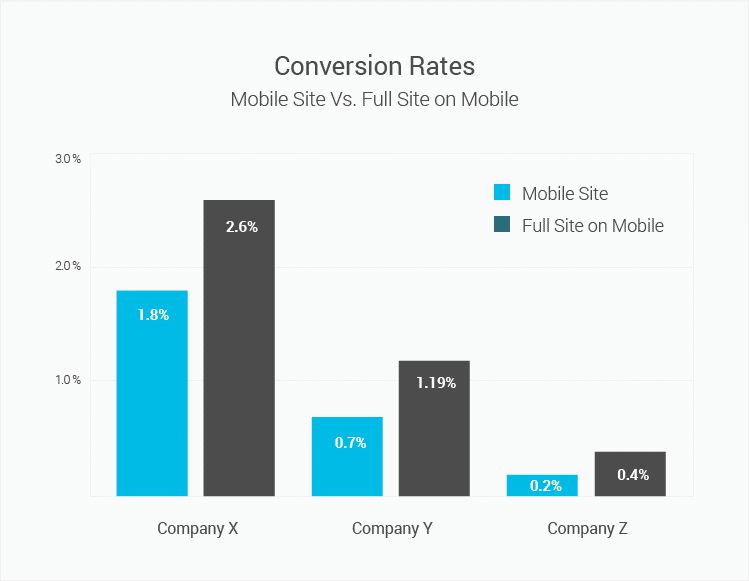Mobile marketing is still a relatively new concept for brands and businesses. To put it into perspective, 15 years ago, hardly anyone had a mobile phone, and mobile marketing was virtually nonexistent. Today, however, more than 75% of the US population is using mobile technology, yet mobile marketing still remains in its infancy among many brands. In fact, there are too many companies that fail to take advantage of the potential that lies in mobile marketing.
Mobile searchers lead to action
Companies can benefit exponentially by investing in mobile marketing. According to iAcquire, 70% of users who start their searches on mobile devices end up taking action on websites within one hour.
Consumers crave information, especially when it’s served on a screen of their mobile phone. In 2015, Google revealed receiving more searchers from mobile devices than desktops in as many as 10 countries worldwide (including the US and Japan).
But there’s a catch. Last year, Google implemented an algorithm that favors responsive (mobile-friendly) websites in search results. This step shouldn’t be a surprise since as many as 40% of users do not browse a website further, regardless of information and value it holds, if it’s not responsive – the majority will click on to another, mobile-friendly website.

So to keep traffic on a website, its mobile responsiveness is imperative and cannot be ignored.
Customers want businesses to go mobile
These days information is already one swipe of a finger away, but customers still want more. A study undertaken in January, 2015, revealed that 44% of consumers would like it if brands sent them deals and special offers to their mobile devices.
By sending tailored offers directly onto screens of customers’ mobile phones, companies not only increase their sales but also meet consumers’ desire to be up to date. If customers like what they see, they can purchase a product or service with just one tap. This approach is convenient and effective for both the brand and the target audience.
Mobile marketing leads to greater conversions
Yes, extending a company’s marketing strategy to mobile marketing increases brand’s overall conversion rates, but only when paired with good old desktop traffic. Yet ABI Research suggests that, in 2017, 24% of all online sales will be through mobile devices. This further underlines the sizable potential mobile marketing holds for the future.
And when it comes to website searches, already the number of queries from mobile phone exceeds desktop searches.

But even though the idea of buying products through a mobile device is still a new concept for consumers, the phenomena gains momentum each year. One of the biggest worries consumers have today, especially with regard to mobile technology, are privacy issues about their data and personal information. These fears are by no means unfounded – we hear about data leakages every day now.
There’s also another factor that puts potential mobile customers off – poor mobile website optimization, which causes 41% of users to leave a mobile website without even bothering to read it.
Mobile marketing is still evolving and businesses might not be aware yet how to fully leverage this technology to get ahead, but they undoubtedly have to wrap their heads around it as soon as possible. Rise in mobile purchasing is only a matter of time, and remember, the competition never sleeps.
Things to consider when creating a mobile marketing strategy
There are three key components businesses should think about when planning a mobile marketing strategy. They are:
Responsive website
A responsive website is an absolute must for all businesses, regardless of their goals and objectives. With the majority of online searchers originating from a mobile device, websites that are not responsive lose considerable chunks of their organic traffic.
A recent study found that 60% of Americans use their cell phones to access the Internet, while 75% said they used their mobile phone for various shopping activities last Christmas.
With 4G/LTE technologies becoming readily available all over the US, the demand for mobile-friendly websites is continually on the rise, and businesses should respond to the demanding needs of the market to keep their position.
Mobile Application development
Yet those are mobile applications that are truly the gist of mobile marketing. Mobile applications generate higher conversion rates compared to mobile websites and desktop websites, especially in retail and travel industry.
 Source: Snappii
Source: Snappii
Mobile apps by design offer a better user experience than mobile websites; thus, making purchases easier; plus they are usually downloaded by loyal customers who, in general, purchase more often than new customers.
Of course, developing high-powered apps isn’t cheap, but it’s a profitable investment which can increase sales, retain customers, and considerably increase customer lifetime value.
Tailored apps that allow consumers to buy products fast offer customers more shopping convenience, at the same time increasing impulse buying. Because consumers are more prone to reacting (buying) upon seeing real-time pop-up offers and special deals streamed directly to their mobiles via branded applications.
Summary
Businesses that don’t cater to the needs of mobile and tablet users are hindering their earning potential. Underestimating the power of mobile consumer can have its reflection on the brand’s sales and traffic – if not exactly causing them to drop, then surely not going up. With mobile marketing gaining in force each year, it will soon become a pivotal part of every brand’s online marketing strategy.

